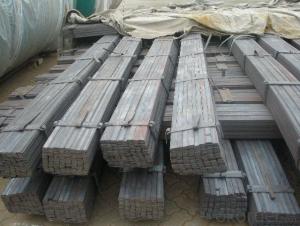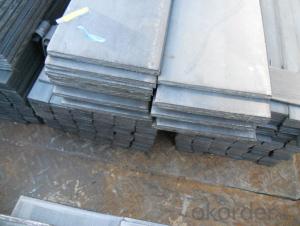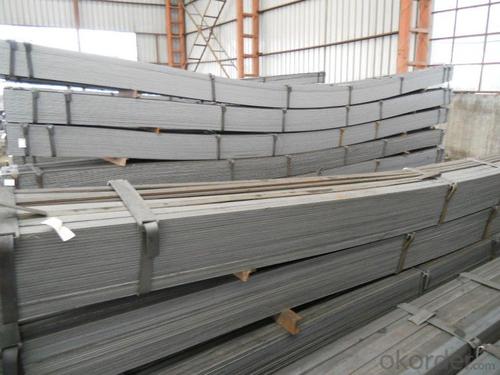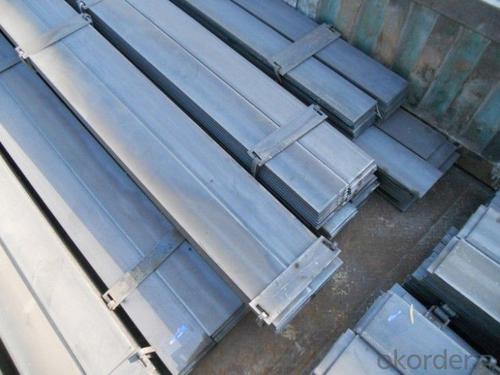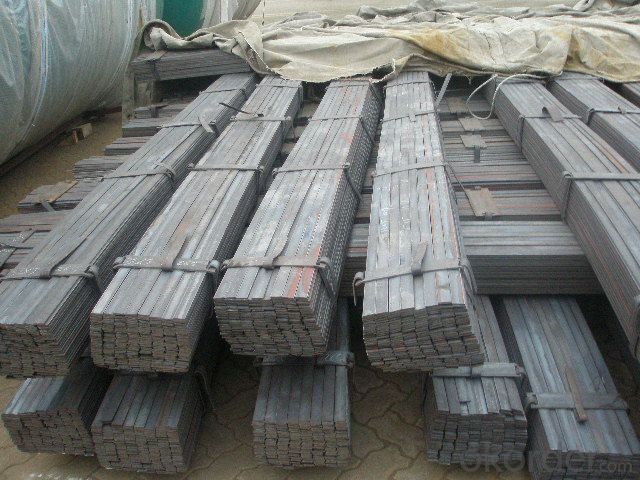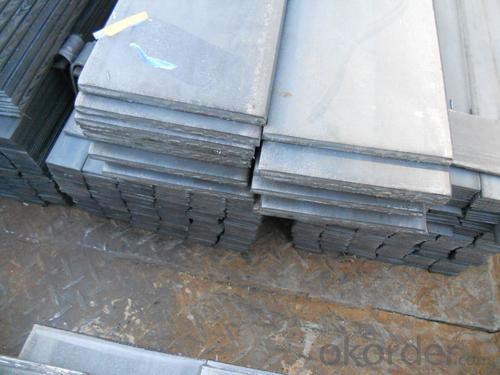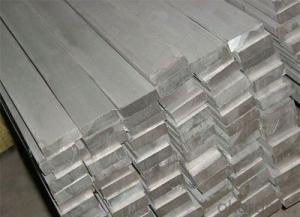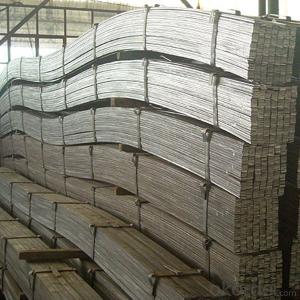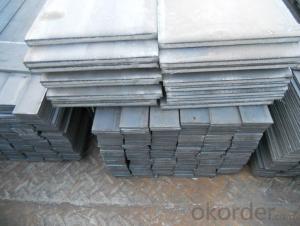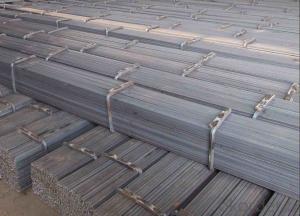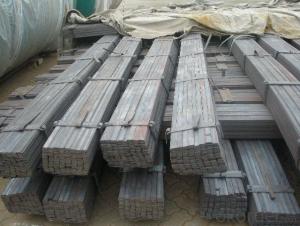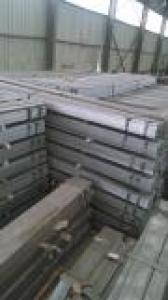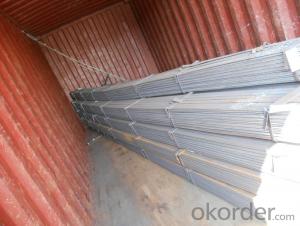Hot Rolled Steel Flat Bars with Material Grade Q235
- Loading Port:
- Tianjin
- Payment Terms:
- TT OR LC
- Min Order Qty:
- 25 m.t.
- Supply Capability:
- 10000 m.t./month
OKorder Service Pledge
OKorder Financial Service
You Might Also Like
Product Description:
OKorder is offering high quality Slit Cutting Flat Bar at great prices with worldwide shipping. Our supplier is a world-class manufacturer of steel, with our products utilized the world over. OKorder annually supplies products to European, North American and Asian markets. We provide quotations within 24 hours of receiving an inquiry and guarantee competitive prices.
Product Applications:
Slit Cutting Flat Bars are ideal for structural applications and are widely used in the construction of buildings and bridges, and the manufacturing, petrochemical, and transportation industries.
Product Advantages:
OKorder's Slit Cutting Flats Barare durable, strong, and resist corrosion.
Main Product Features:
· Premium quality
· Prompt delivery & seaworthy packing (30 days after receiving deposit)
· Corrosion resistance
· Can be recycled and reused
· Mill test certification
· Professional Service
· Competitive pricing
Product Specifications:
Manufacture: Slit Cutting
Grade: Q195 – 235
Certificates: ISO, SGS, BV, CIQ
Length: 6m – 12m, as per customer request
Packaging: Export packing, nude packing, bundled
Chemical composition of Q235
Alloy No | Grade | Element(%) | ||||
C
| Mn
| S
| P
| Si
| ||
Q235
|
B
|
0.12—0.20 |
0.3—0.7 |
≤0.045 |
≤0.045
|
≤0.3
|
Physical properties of Q235
Alloy No | Grade | Yielding strength point(Mpa) | Tensile strength (Mpa) | Elongation after fracture(%) | ||||||
Thickness (mm) | Thickness (mm) | |||||||||
≤16 | >16--40 | >40--60 | >60--100 | ≤16 | >16--40 | >40--60 | >60--100 | |||
≥ | ≥ | |||||||||
Q235 |
B |
235 |
225 |
215 |
205 |
375--500 |
26 |
25 |
24 |
23 |
FAQ:
Q1: Why buy Materials & Equipment from OKorder.com?
A1: All products offered byOKorder.com are carefully selected from China's most reliable manufacturing enterprises. Through its ISO certifications, OKorder.com adheres to the highest standards and a commitment to supply chain safety and customer satisfaction.
Q2: What is the normal tolerance of Hot Rolled Mild Steel Angle Beams for Structures and for Buildings?
A2: Normally 3%-5%, but we can also produce the goods according to the customers' requests.
Q3: How soon can we receive the product after purchase?
A3: Within three days of placing an order, we will begin production. The specific shipping date is dependent upon international and government factors, but is typically 7 to 10 workdays.
Images:
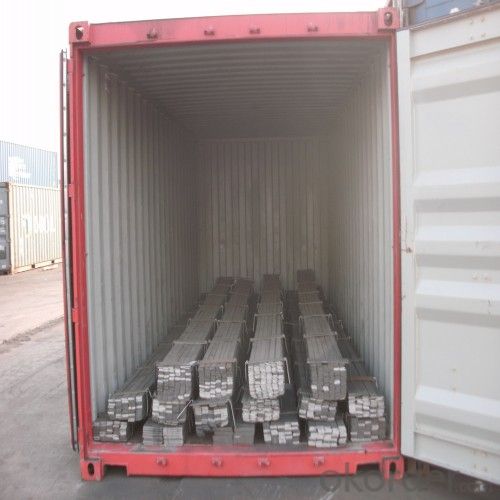
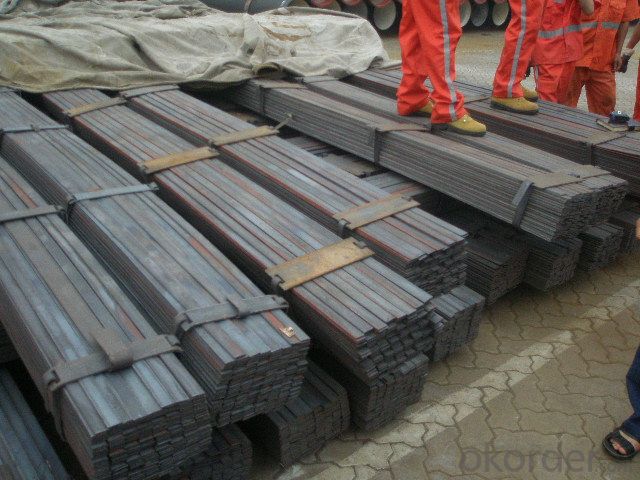
- Q: Can steel flat bars be customized in terms of size and shape?
- Yes, steel flat bars can be customized in terms of size and shape. Steel flat bars are typically available in standard sizes, but they can be cut and reshaped according to specific requirements. Customization can involve altering the length, width, and thickness of the bar to meet specific dimensions. Additionally, steel flat bars can also be bent or curved to achieve desired shapes. This flexibility in customization allows for the adaptability of steel flat bars to various applications and design needs.
- Q: How do steel flat bars perform in terms of UV resistance?
- Steel flat bars do not have inherent UV resistance properties. This means that when exposed to ultraviolet (UV) radiation from sunlight, steel flat bars can experience negative effects. Over time, prolonged exposure to UV rays can cause steel to degrade and become brittle. This can result in discoloration, oxidation, and structural weaknesses in the steel flat bars. To mitigate these issues and improve UV resistance, various methods can be employed. One common approach is to apply protective coatings to the steel surface, such as paint or specialized finishes. These coatings act as a barrier, shielding the steel from direct UV exposure and preventing degradation. Additionally, stainless steel flat bars can exhibit better resistance to UV radiation compared to carbon steel. Stainless steel contains chromium, which forms a passive oxide layer that provides some level of natural UV protection. However, it is important to note that even stainless steel can still be affected by long-term exposure to intense UV rays. Ultimately, when considering steel flat bars for outdoor or UV-exposed applications, it is crucial to take into account the specific environment, level of UV exposure, and the need for additional protective measures to ensure the longevity and performance of the steel flat bars.
- Q: What is the price range of steel flat bars?
- Several factors, such as the size, grade, and quality of the steel, can cause the price range of steel flat bars to vary. Typically, the price range for these bars is between $10 and $100 per bar. However, specialty or high-grade steel flat bars may be priced even higher, going up to $200 or beyond. To obtain the most accurate and current pricing information, it is advisable to consult local suppliers or refer to online sources.
- Q: Can steel flat bars be bent or shaped?
- Yes, steel flat bars can be bent or shaped. Steel is a malleable material, which means it can be easily formed and manipulated. The process of bending or shaping steel flat bars involves applying force to the material, either manually or using machines such as hydraulic presses or bending brakes. The degree to which a steel flat bar can be bent or shaped depends on various factors such as the thickness and composition of the steel, as well as the desired shape or angle. However, it is important to note that excessive bending or shaping may cause the steel flat bar to weaken or deform, so it is essential to follow proper techniques and guidelines to ensure the structural integrity of the material.
- Q: What are the benefits of using steel flat bars in architectural projects?
- There are several benefits of using steel flat bars in architectural projects. Firstly, steel flat bars offer high tensile strength and exceptional durability, making them suitable for supporting heavy loads and withstanding harsh weather conditions. Secondly, their versatility allows for various applications such as framing, support structures, and decorative elements. Additionally, steel flat bars are malleable, making it easier to shape and customize according to specific project requirements. Moreover, steel's corrosion resistance minimizes the need for regular maintenance and ensures long-term performance. Lastly, steel is a sustainable and environmentally friendly material, as it can be recycled indefinitely without losing its properties, reducing the overall environmental impact of architectural projects.
- Q: Are steel flat bars available in different shapes, such as round or square?
- No, steel flat bars are typically available only in a flat shape. However, if you are looking for round or square steel bars, there are other types of steel bars that are specifically manufactured in those shapes. Round bars are cylindrical in shape, while square bars have straight, uniform sides, forming a square shape. These different shapes of steel bars cater to specific applications and are readily available in the market.
- Q: Can steel flat bars be polished?
- Yes, steel flat bars can be polished. Polishing steel flat bars involves using abrasive materials to remove any imperfections on the surface and create a smooth and shiny finish.
- Q: What are the standard sizes of steel flat bars?
- The standard sizes of steel flat bars can vary depending on the country and industry. However, common standard sizes typically range from 1/8 inch to 1 inch in thickness and 1/2 inch to 12 inches in width.
- Q: What are the common load-bearing capacities of steel flat bars?
- The load-bearing capacity of steel flat bars can vary depending on several factors such as the dimensions of the bar, the type of steel used, and the specific application. However, there are some common load-bearing capacities that can be generally expected for steel flat bars. In general, steel flat bars have high tensile strength and are capable of supporting heavy loads. The load-bearing capacity is primarily determined by the width, thickness, and length of the bar. For example, a standard steel flat bar with a width of 1 inch and a thickness of 1/4 inch can typically support a load of up to 3,000 pounds. If the width is increased to 2 inches, the load-bearing capacity can double to around 6,000 pounds. Similarly, increasing the thickness to 3/8 inch can also increase the load-bearing capacity. It is important to note that these load-bearing capacities are general guidelines and may vary depending on the specific steel grade used. Different steel grades have different mechanical properties, and some grades may have higher load-bearing capacities than others. In addition to the dimensions and steel grade, the load-bearing capacity of steel flat bars can also be influenced by factors such as the support conditions, the distribution of the load, and the span or length of the bar. It is recommended to consult engineering design codes and standards or consult with a structural engineer for accurate load-bearing capacity calculations for specific applications.
- Q: Are steel flat bars suitable for fabrication of machinery parts?
- Yes, steel flat bars are suitable for the fabrication of machinery parts. Steel is a strong and durable material that is commonly used in the manufacturing and construction industries. Steel flat bars provide stability and support, making them ideal for creating various components of machinery. They can be easily cut, welded, and shaped to meet specific design requirements. Additionally, steel flat bars have excellent mechanical properties, such as high tensile strength and good ductility, which ensure the longevity and reliability of machinery parts. Overall, steel flat bars are a popular choice for fabricating machinery parts due to their strength, versatility, and ability to withstand heavy loads and harsh environments.
Send your message to us
Hot Rolled Steel Flat Bars with Material Grade Q235
- Loading Port:
- Tianjin
- Payment Terms:
- TT OR LC
- Min Order Qty:
- 25 m.t.
- Supply Capability:
- 10000 m.t./month
OKorder Service Pledge
OKorder Financial Service
Similar products
Hot products
Hot Searches
Related keywords


